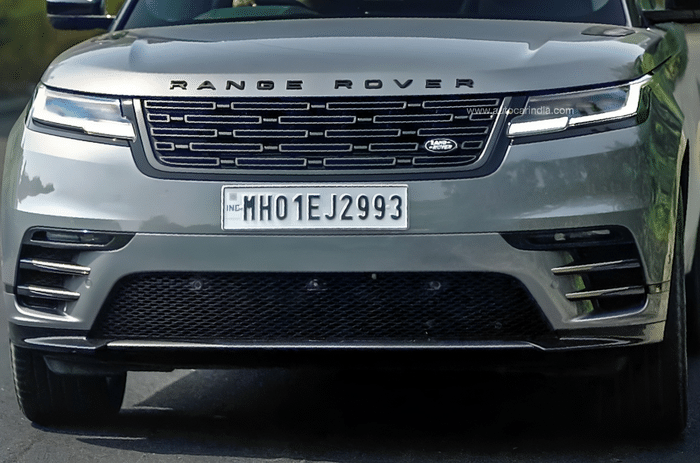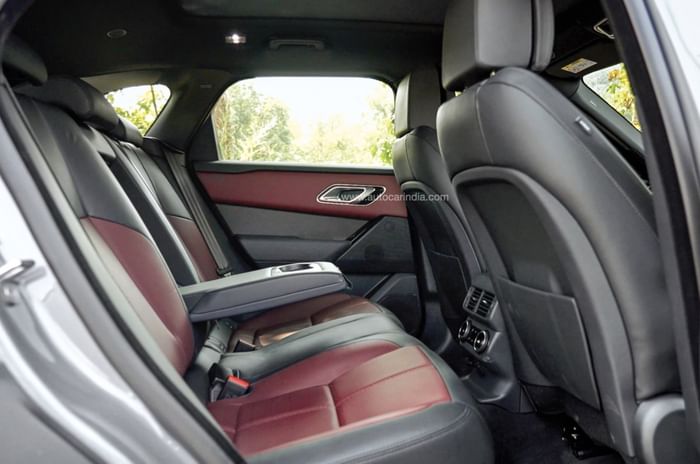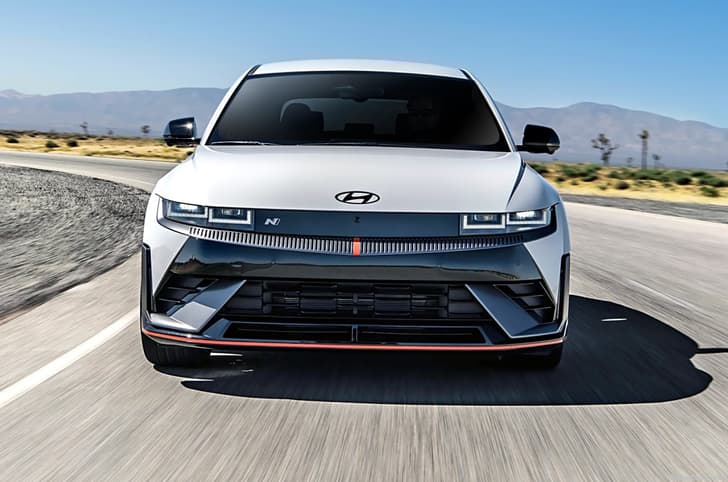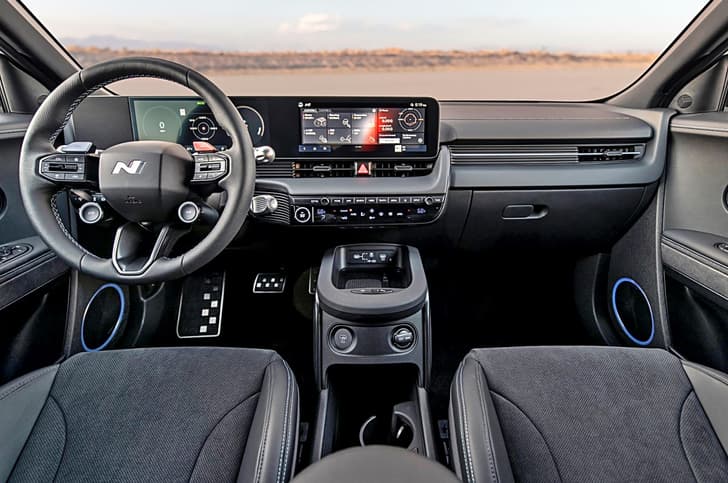When the Velar first broke cover in 2017, we called it one of the sexiest SUVs around, and that holds true even today. Its makers too think the same way, and so changes to the 2023 Range Rover Velar are limited to small styling tweaks.
Range Rover Velar facelift exterior design and engineering – 9/10
Design changes are minimal, but it remains a handsome SUV.

There’s a new grille design on the Velar and slim LED pixel lamps replace the matrix LEDs with a new DRL signature. Headlamp washers are gone, and the bonnet gets a new trim element similar to the ones on the sides. The alloys are new, the rear bumper has been tweaked and the reflectors are now horizontal instead of vertical. They are small differences but it is still a handsome car.
Range Rover Velar facelift interior space and comfort – 8/10
Cabin gets a minimalist theme with a new curved display; the seats are comfy and there’s ample legroom on offer.
The more significant change, however, is on the inside, where the look has gone very minimalistic. The terrain responsive rotary dial selector is gone from the central console, and only the gear selector remains. All controls have moved to the 11.4-inch curved dashboard display. The graphics are crisp, and the UI intuitive to use, and thanks to the curve, the screen's visibility is always good with no glare, even with the sunroof open.

However, changing the fan speed or using the climate control requires looking away and running through a menu; it is the same for the terrain response as well. And speaking of the screen, there’s now wireless Apple CarPlay and Android Auto.
Seating at the front and rear is comfy with ample legroom on offer. While the seats are well-cushioned, they are not the theatre style of bigger Range Rovers. You also sit lower and while that offers good headroom, the window line feels higher and the window area is small. Luckily, the panoramic roof extending over the rear seat makes it feel airy.

While the car's width comfortably allows three passengers at the rear, the seat contouring is more suited for two. Plus, with the high tunnel and console coming way back into the rear, there is no leg room for the third passenger.
Boot space isn't the best for an SUV of this size, but the Velar offers the flexibility of split-folding rear seats. What is an advantage, though, is that it comes with a standard full-size spare.
Range Rover Velar facelift features and safety – 8/10
Feature highlights include massaging front seats, a Meridian sound system and 360-degree camera.
In terms of features, there’s a 360-degree camera with an under-bonnet view, handy for off-roading or navigating potholes. There’s 20-way massage front seats, a power recline for the rear seats, an air purifier, wireless charging, a Meridian sound system, a powered tailgate, a panoramic sunroof and four-zone climate control.
Range Rover Velar facelift performance and refinement – 7/10
2.0 petrol and diesel put out over 200hp; diesel has lag initially but builds power nicely after that.
For India, the Velar comes with the 2.0-litre Ingenium petrol and diesel engines. The petrol produces 250hp and 365Nm and can hit 100kph in 7.5 seconds, while the diesel produces 204hp and 430Nm. It also has a mild-hybrid system and pulls up the 0-100kph dash in 8.3 seconds. Both engines are mated to an 8-speed automatic gearbox.
For our test drive, we had the diesel, which has enough power, but there is some lag, and up to 1,800 rpm, the needle moves slowly. After that, there is a surge of power and it’s all smooth sailing. However, that surge, combined with the snappy gearbox, means a certain amount of jerkiness driving slowly in traffic. You need to keep the engine above 2,000rpm and from there, it builds up power nicely and settles into cruising speeds comfortably.

The auto box shifts up early, so you often find yourself in higher gears and for a quick overtake, you require a tug on the paddles as the gearbox is a bit lazy. To counter that, one can either shift into Sport or Dynamic mode and suddenly, the Velar feels energetic and responsive. Dynamic mode has other advantages, too. It keeps the Velar more settled overall on uneven roads without feeling too firm. Comfort mode softens the ride and keeps the passengers cushy at low speeds, but even a little build-up in pace makes it roll and pitch on bad roads. Dynamic mode feels better, keeping the Velar hunkered down to the road nicely. As for the noise insulation, the Velar is very hushed and serene on the move.
Range Rover Velar facelift mileage – 6/10
Expect real-world mileage to be between 7-14kpl, depending on usage.
While we didn’t get a chance to test the fuel efficiency of the Velar, expect both 200+hp engines to return anywhere between single digits to the low teens in the real world, depending on the driving style and usage pattern.
Range Rover Velar facelift ride comfort and handling – 7/10
Ride is comfortable and it feels confident around corners; is quite capable off road too.
While the ride quality is very comfortable, it will thud through the larger potholes, so don't expect the plushness of the bigger Range Rovers that make the road surface feel like glass. Meanwhile, the Velar’s air suspension can lower the car by 10mm for easy ingress and egress, and for off-roading, you can raise the car by 25mm over the normal height.

The Velar was built to be one of the brand’s more road-focused SUVs, and it does feel confident and surefooted. The steering also weighs up well around corners but is not sharp or involving, and the Velar is more suited to long-distance cruising than hustling around corners.
Now, while this Range Rover claims to be more road-focused, it can do a fair bit of off-roading too, and with different modes, you can tackle snowy roads with ease if you live up north. And for the rest of us, the 600mm wading depth is a plus to tackle any monsoon flood.
Range Rover Velar facelift price and verdict – 7/10
It’s a comfy and attractive looking SUV that manages to slightly undercut its rivals.
 The Velar is sure footed but prefers long-distance cruising over corner carving.
The Velar is sure footed but prefers long-distance cruising over corner carving.
JLR has priced both the petrol and diesel versions at an identical Rs 87.9 lakh (ex-showroom, India), and that puts it just slightly under rivals like the Mercedes-Benz GLE and the BMW X5. But these cars have lifted the game so the Velar now has a tougher playing field, one in which its tough build and comfortable and minimalist interior will have to grab customers’ attention. And if all of that is not enough, Range Rover is banking on that heart-tugging design to keep it in the fray.







































